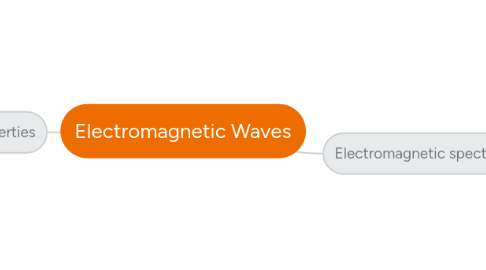
1. Properties
1.1. Nature
1.1.1. Non-mechanical
1.1.1.1. No medium required to propagate
1.1.2. Transverse
1.1.2.1. Oscillation perpendicular to wave direction
1.1.3. Oscillation perpendicular to each other
1.1.3.1. Magnetic field
1.1.3.2. Electric field
1.2. Speed
1.2.1. constant of 3.0x10^8 m/s
1.2.2. light
1.3. c=fλ
1.3.1. general equation: ν=fλ
1.3.1.1. where c is the speed of light
1.3.1.1.1. 3.0x10^8 m/s
1.3.1.2. where f is the frequency
1.3.1.3. where λ is the wavelength
1.4. transfer energy
2. Increasing frequency
3. Electromagnetic spectrum
3.1. Continuous range of frequencies of electromagnetic waves
3.1.1. Radio waves
3.1.1.1. Uses
3.1.1.1.1. Radio broadcasting
3.1.1.1.2. TV broadcasting
3.1.1.1.3. Remote control cars
3.1.1.1.4. Walkie-talkie
3.1.1.1.5. Radar
3.1.1.1.6. Navigation systems
3.1.1.1.7. Telecommunication
3.1.2. Microwaves
3.1.2.1. Uses
3.1.2.1.1. Microwave oven
3.1.2.1.2. Transmission
3.1.3. Infrared
3.1.3.1. Uses
3.1.3.1.1. Remote controllers
3.1.3.1.2. Sensors
3.1.4. Visible spectrum/Light
3.1.4.1. Extreme ends of spectrum
3.1.4.1.1. Red
3.1.4.1.2. Violet
3.1.4.2. Uses
3.1.4.2.1. Sight
3.1.4.2.2. Optical fibres
3.1.4.2.3. Light photography
3.1.4.2.4. Endoscopy
3.1.5. High energy/frequency waves
3.1.5.1. Ultravoilet
3.1.5.1.1. 3 categories of differing energy
3.1.5.1.2. Uses (general)
3.1.5.2. X-rays
3.1.5.2.1. Uses
3.1.5.3. Gamma Waves
3.1.5.3.1. Uses
3.1.5.3.2. Source
3.1.5.4. Ionisation
3.1.5.4.1. Waves excite electrons
3.1.5.4.2. Effects
3.1.5.4.3. Source
